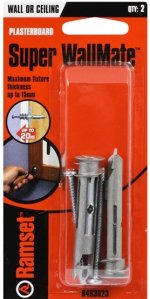ear3
Member
- Joined
- Jul 24, 2014
- Messages
- 4,341
Spec-ing a shelving job for a friend that's going to occupy about a 4.5 ft wide by 11 foot tall space on a wall made of drywall. The 12" shelves are going to be filled with large, heavy art books, so I need to come up with something that will be secure enough to accommodate that load.
I don't think he wants a full, wooden built-in, so instead I'm thinking that the double-slotted wall tracks/standards should do the trick -- 4 of the 8 ft. long vertical tracks spaced more or less 16" apart. Something like this: http://www.mcmaster.com/#standard-shelving-brackets/=z4bnyq
So three questions:
1. In terms of maximizing holding power, is it better to use a heavy duty hollow wall anchor -- like a toggle bolt -- or instead try to anchor the track on the metal studs?
2. And are toggle bolts the strongest drywall anchor, or is there something even stronger?
3. Any recommended source for the tracks and brackets? The ones on McMasterCarr look decent enough -- plus they come in 8 ft. lengths which is basically the minimum I can do for these 11 foot walls, as my friend wants to run the shelves as close to the floor as possible. But maybe you know of a supplier that offers tracks in 9 or 10 foot lengths?
Thanks for any advice.
I don't think he wants a full, wooden built-in, so instead I'm thinking that the double-slotted wall tracks/standards should do the trick -- 4 of the 8 ft. long vertical tracks spaced more or less 16" apart. Something like this: http://www.mcmaster.com/#standard-shelving-brackets/=z4bnyq
So three questions:
1. In terms of maximizing holding power, is it better to use a heavy duty hollow wall anchor -- like a toggle bolt -- or instead try to anchor the track on the metal studs?
2. And are toggle bolts the strongest drywall anchor, or is there something even stronger?
3. Any recommended source for the tracks and brackets? The ones on McMasterCarr look decent enough -- plus they come in 8 ft. lengths which is basically the minimum I can do for these 11 foot walls, as my friend wants to run the shelves as close to the floor as possible. But maybe you know of a supplier that offers tracks in 9 or 10 foot lengths?
Thanks for any advice.


